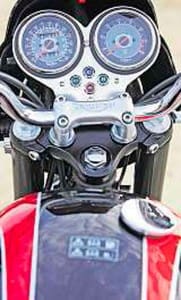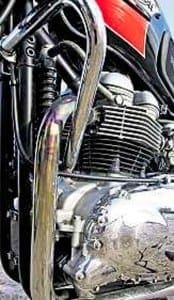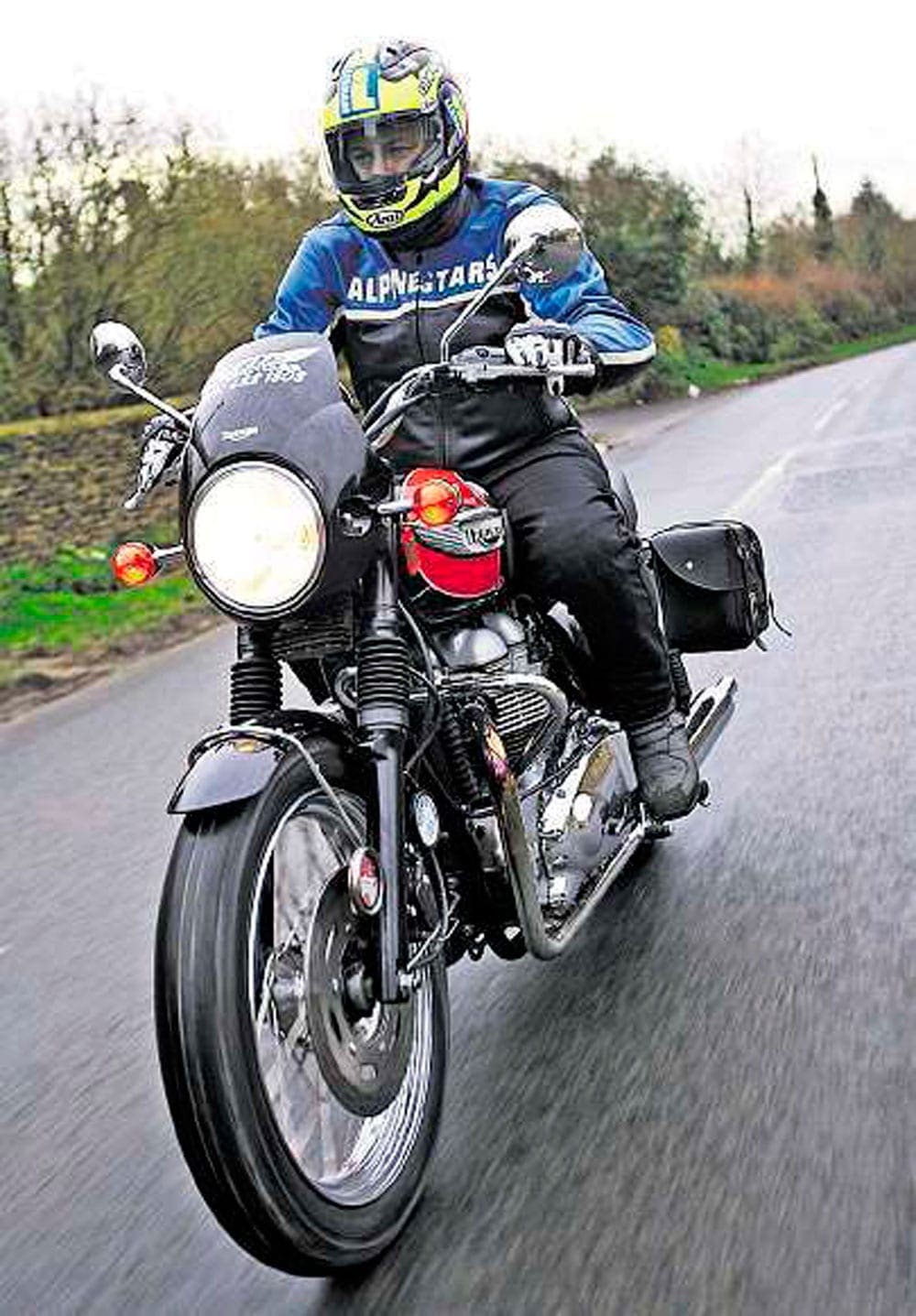Unashamedly celebrating the past, the Bonneville T100 serves a perfect reminder of how things used to be back in the days when open-face helmets were the norm and the Ace Café was doing a roaring trade with rockers.
One of three Bonnevilles in the current range, the T100 is the most authentic replica of the original era of the parallel twin. The wonderful aircooled engine, spoked wheels, pea-shooter silencers and fork gaiters are just some of the things that set it apart from the other two versions. Our test bike had the additional official aftermarket fitments of chromed crash bars, leather panniers, screen and a stepped seat to make it even more eye-catching and useful.
 I have to admit, I totally enjoyed riding the Triumph. I found it a thoroughly charming and relaxing bike that’s extremely therapeutic to spend time with. It didn’t hurt that I occupied most of my Boxing Day aboard the T100, a day when there was virtually no traffic around to spoil the flow and satisfaction of the ride. And trundling along some of Gloucestershire’s finest rural routes somehow seemed the perfect stomping ground for this very British iron.
I have to admit, I totally enjoyed riding the Triumph. I found it a thoroughly charming and relaxing bike that’s extremely therapeutic to spend time with. It didn’t hurt that I occupied most of my Boxing Day aboard the T100, a day when there was virtually no traffic around to spoil the flow and satisfaction of the ride. And trundling along some of Gloucestershire’s finest rural routes somehow seemed the perfect stomping ground for this very British iron.
It was strange to have to fiddle with its manual choke before I fired it up, and checking the fuel tap’s position brought chuckles of nostalgia too. There was a slight disappointment not to hear a little more of a roar from the pea-shooters to match the Triumph’s masculine architecture. Though in these days of ever-tightening noise regs maybe that shouldn’t be a surprise. In fact it’s a wonder the Bonneville’s carbs are allowed, given their reputation for ‘dirtying’ the atmosphere.
 They are one of the more welcome features of this thoroughly lovely motorcycle, giving it clean, glitch-free fuelling and reminding us of how much some fuel-injection systems need to improve to match the faultless nature of these ‘mixers’. Nicely warmed, I headed off on the T100 with no special plan or destination and found myself smiling from the off. Its capacity might suggest it’s a ‘big’ bike, but the reality is a low, light and lithesome machine that requires little more strength to manage than a middleweight commuter bike. It encourages an easy-going style of riding and prompts a feeling of thorough contentment at all times.
They are one of the more welcome features of this thoroughly lovely motorcycle, giving it clean, glitch-free fuelling and reminding us of how much some fuel-injection systems need to improve to match the faultless nature of these ‘mixers’. Nicely warmed, I headed off on the T100 with no special plan or destination and found myself smiling from the off. Its capacity might suggest it’s a ‘big’ bike, but the reality is a low, light and lithesome machine that requires little more strength to manage than a middleweight commuter bike. It encourages an easy-going style of riding and prompts a feeling of thorough contentment at all times.
One of the first impressions of the bike is just how sorted it is. If Meriden had been able to produce something this good in its day then no doubt there’d still be a factory there now. But the real beauty of this bike is not just what it does, but how it makes you feel. Just owning the Bonneville and all it represents, will probably be as satisfying as riding it – though that experience alone is pretty pleasurable.
The 865cc air-cooled parallel twin is a really nice engine to use with a lovely linear delivery that makes acceleration prompt, easy and friendly. The five-speed gearbox is beautifully light and slick, but thanks to the amount of power and torque available from very low rpm, there’s little need to use it too often. I’m not sure how Triumph has managed to do it, but the engine really does feel alive thanks to a ‘feeling’ of vibration. Yet that pulsing must be imaginary as it doesn’t actually reach any part of the bike you’re connected to like the bars or footrests, and the mirrors constantly stay clear. At very low rpm in the bigger gears there’s a tendency for the engine to snatch very slightly, so it’s better to drop down a cog or two to prevent that. But at all other engine speeds, prompt and clean throttle response is the order of the day.
 The fluidity of the motor is matched by the chassis to give handling that’s just as easy and manageable. There’s a planted feel from the bike over most surfaces and virtually all speeds. And given its very basic engineering and specification that shows the Hinckley engineers definitely got their sums right with things like frame geometry and suspension settings.
The fluidity of the motor is matched by the chassis to give handling that’s just as easy and manageable. There’s a planted feel from the bike over most surfaces and virtually all speeds. And given its very basic engineering and specification that shows the Hinckley engineers definitely got their sums right with things like frame geometry and suspension settings.
With sweet steering and a nice feeling from the Metzeler tyres, twisting through the Gloucestershire countryside couldn’t have felt that much nicer – even if the air temperature was higher than the 1°C I rode through! There is a feeling of the rear shocks getting a little choppy in their action over some of the worst ripples, but it certainly isn’t bad enough to move the wheel off line.
The handling is especially good at very slow pace, making it very-well suited to use in town. Feet-up U-turns are simple and the slimness of the bike allows easy filtering, even with the panniers. The brakes have a nice action too. The front caliper is a very simple two-piston sliding affair, like those fitted to the earliest of the Hinckley-produced Triumphs, and doesn’t produce the sharpest stopping possible. Even so, it’s still strong enough and its progression and feel will reduce the chance of any ham-fisted lock ups.
The overall poise of the Triumph will be very much welcomed by those either new to biking or returning to it after a long break. And I can somehow see a lot of those types spending their money on this bike. It would give them a very satisfying impression of what biking is all about and how much fun it can be.
It’s been a long time since I took my time over rides and benefitted as much from them as I did on the Bonneville. It allowed me to absorb more of the area where I live, rather than oblige me to focus just on the road as you sometimes have to on more intense sportbikes. I’m not a man who would choose a cruiser as a bike to own. But I could certainly see me opting for the quiet life on one of these laid-back lovelies not far from now. And I have to admit, I didn’t expect to come out with that sort of remark for a few years yet! I think it’s a marvellous machine.
Tech Spec
■ Engine: 865cc, air-cooled, 8-valve, dohc, parallel twin
■ Power: 67bhp @ 7500rpm
■ Torque: 51ft-lb @ 5800rpm
■ Transmission: 5-speed
■ Final Drive: Chain
■ Chassis: Tubular steel cradle
■ Suspension: Front – 41mm inverted telescopic forks, no adjustment. Rear – twin shocks, adjustable preload
■ Brakes: Front – single 300mm disc with twin-piston caliper. Rear – single 255mm disc with twin-piston caliper
■ Wheels/Tyres: Front – 100/90-19 Rear – 130/80-17
■ Seat height: 775mm
■ Wheelbase: 1500mm
■ Dry weight: 205kg
■ Fuel capacity: 16 litres
■ Price: £4395
■ Contact: 0161 432 1303,




